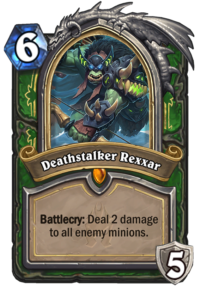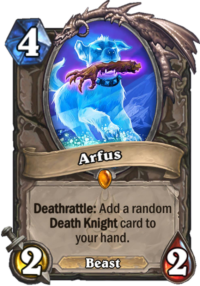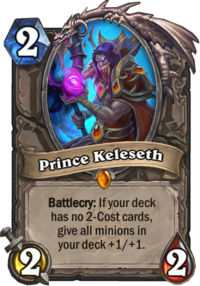With the new Hearthstone year inching ever closer and the upcoming rotation getting rid of some iconic and seemingly omnipresent tools in Standard, it’s time to examine how the different goodies introduced over the course of The Year of the Mammoth fared over the course of their allotted time in the game’s main format. What bombed like hand-buffing and Mean Streets of Gadgetzan and what changed the face of Hearthstone as we know it? This series of articles will examine every keyword introduced in this period, now looking at the absolutely game-defining Knights of the Frozen Throne set.
And They Do Not Fear
It goes without saying that the Death Knights were the axis around which most of the expansion – and essentially every subsequent metagame – revolved. Flashy and awesome transformation effects coupled with a massive change in the board state and gameplay strategies: truly a design goldmine. They also continued a long-established trend in Hearthstone where Team 5 would take an already existing facet of gameplay – in this case, Lord Jaraxxus – and expand it into a full-fledged flagship concept. Unfortunately, their resource generation abilities were so strong that they basically dominated the metagames and greatly restricted the viable archetypes at any given time going forward.

There were clear attempts to combat the endless stream of resources with cards like Dead Man's Hand, Hadronox and Eternal Servitude (alongside aggressive draw tools along the lines of the infamous Ultimate Infestation), not to mention the ability to interact with our opponent’s deck with Gnomeferatu and Skulking Geist (plus Death Grip and the Howlfiend–Treachery combo). No such cards would be printed going forward apart from the nigh unplayable Void Contract.
These tools would not be enough to combat the Death Knights’ impact. Essentially all of them saw extended Constructed play – even Uther of the Ebon Blade eventually found a home in OTK strategies – and some, like Shadowreaper Anduin, had oppressive synergies forming top-tier decks that basically couldn’t be combated. Worse yet, much like how Yogg-Saron, Hope's End’s original form served as an emergency valve when behind, most Death Knights were good enough to enable a late-game strategy on their own without any additional support, leading to heavily warped situations perhaps best exemplified by Deathstalker Rexxar’s effect on the Control Warrior matchup. A single card slot sacrificed in any Hunter deck gave it a very viable resource generation strategy.
Team 5 certainly learned the right lesson: the cards were exciting, flashy and popular and therefore warranted a return in later sets, but their power levels had to be massively adjusted going forward. Hero cards remained in the game in the later sets as well – only as a single-cared seasoning of sorts so as to avoid overshadowing the shiny new goodies –, but now they’re no longer are they capable of single-handedly delivering on a late-game strategy without additional support tools. With the original Death Knights’ rotation to Wild, they’ll be able to avoid to sort of awkward overlaps like Shaman and Hunter in the current Standard environment potentially rolling from one of these Hero cards to another mid-match.
The Lich King’s Gifts
Technically, Lifesteal also made its official debut in this set, though MSoG’s Wickerflame Burnbristle already introduced the mechanic and retroactively received the keyword once Knights of the Frozen Throne was released. While none of the neutral Lifesteal minions saw play from the set – In most cases, it was too prohibitively priced to see play on its own in the future as well –, the occasional individual copies made it into certain midrange-ish builds to enable Corpsetaker. Of course, Vicious Scalehide from The Witchwood turned out an entirely different story, highlighting the importance of initiative on these cards. An interesting subplot of the keyword is how it ended up with sort of a tri-class feel over time: only Paladin, Priest and Warlock have more than a single card featuring Lifesteal, and neither Warrior, Hunter or Druid received such a tool to date.

While not technically keywords, Knights of the Frozen Throne also gave us four minions with Deathrattles set to only trigger on the opponent’s turn were released to little fanfare and even less relevancy. Cards with repeated effects like Spreading Plague, Roll the Bones and Defile also constitute unexplored design space, with only Rastakhan’s Cannon Barrage flirting with the same concept ever since.
The three Prince cards also warrant a mention: mini-deckbuilding restrictions of varying impact, they were likely meant to synergize with existing archetypes at a cost of minor sacrifices. Prince Valanar and Prince Taldaram did exactly that – the former finding a home in certain niche Rogue decks and the latter showing up in Cubelock and Malygos Druid every so often – but Prince Keleseth turned out to be a very different story. One has to wonder how effective this card was originally meant to be – what’s for sure is that the community grossly underestimated it, failing to recognize (perhaps understandably) that a deck like this can work with enough viable 1-drops to guarantee a strong tempo presence on the board with or without Keleseth and netting the most possible extra stats per mana if the buff actually comes into play. Unfortunately, it produced very swingy and unfun gameplay experiences (especially when Patches the Pirate was still around), and they were all eventually superseded by the Odd and Even restrictions introduced in The Witchwood.

Out of the three sets we’re set to lose this rotation, Knights of the Frozen Throne was easily the most impactful. The Death Knights single-handedly upset the balance of late-game strategies and pushed midrange archetypes out of the metagame for almost two years. It also provided multiple core cards for the “neutral package” which saw play in almost every class in the form of Prince Keleseth, Saronite Chain Gang, Cobalt Scalebane, Bonemare and The Lich King himself – two of which were eventually nerfed. As iconic and memorable the set was, many of Hearthstone’s frustrating gameplay experiences over the course of the last year and a half – including the aggressive clampdown on card power level with the Year of the Raven releases – stem from this expansion, and its rotation to Wild should hopefully bring along a healthier metagame going forward.

Too much power being dependent on Hero Powers is a bad idea that leads to repetitive gameplay. It didn’t work out well with the Inspire mechanic in The Grand Tournament, nor with Hero cards from The Frozen Throne, nor with Odd and Even decks in The Witchwood. Hopefully Dr. Boom and Hagatha’s hero powers won’t be too destabilizing in the Year of the Dragon.
“Too much power being dependent on Hero Powers is a bad idea that leads to repetitive gameplay.”
Nothing left to say! Thats the reason why i stopped standard ladder few weeks ago.
Hagatha and Boom are pure value, but really random. They can carry for sure, but overall they are balanced i guess.
i will miss the Lichking, such an iconic card and character
Probably one of the best designed/flavored cards in the entire game.